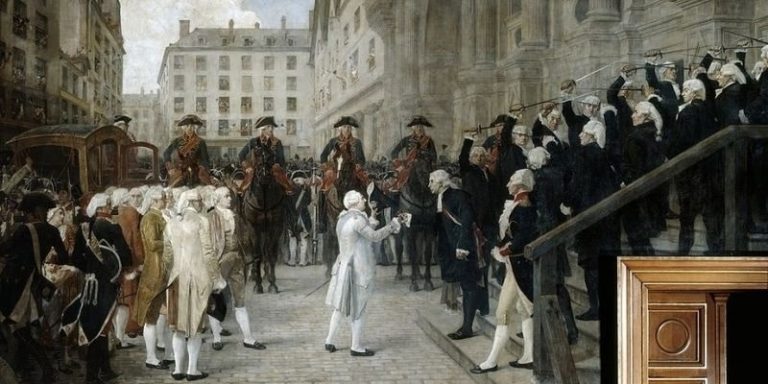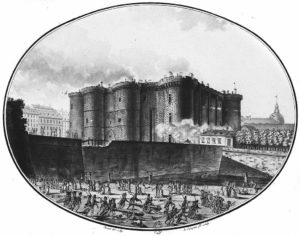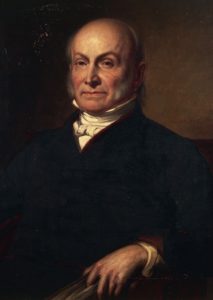This Week in History: July 10 – 16
The fall of the Bastille.
By: Kelli Ballard | July 10, 2022 | 1253 Words

(Photo by Universal History Archive/Getty Images)
“History, despite its wrenching pain, cannot be unlived, however, if faced with courage, need not be lived again.” ~ Maya Angelou
July 14, 1789: The Storming of the Bastille
The Bastille, a royal fortress and prison, was the scene of an uprising that led to the start of the French Revolution. On July 14, 1789, a mob attacked the fortress and took over, forever changing the dynamics in France.
What was the Bastille?
The Bastille was built during the Hundred Years’ War in the 1300s. It was designed to prevent the English from gaining entrance to the city of Paris. The stone building had 100-foot-high walls, a moat, and was guarded by soldiers and Swiss mercenaries.

Engraved view of the Bastille prison at the beginning of the attack (Photo by Roger Viollet Collection/Getty Images)
As a prison, it held those who were considered political rebels, including famed writer Voltaire. Many of these prisoners were held without having a trial, on the king’s order. By the time of the attack, in 1789, the Bastille was scheduled to be demolished and a public square put in its place. There were only seven prisoners at that time.
Events Leading to the Fall of the Bastille
King Louis XVI and Marie Antoinette liked to spend money. Some of it was used to help the colonists during the American Revolution, but all this spending led France near an economic disaster. In 1788, crop failures caused a nationwide famine and bread prices were so high that the average person had to spend about 88% of their income on just that one item. Food riots broke out and unemployment was a serious problem.
French society was divided into three classes: clergy (First Estate), nobility (Second Estate), and commoners (Third Estate). The commoners made up about 98% of the population but had no real power. They started a new group called the National Assembly to represent the people and give them some voting power
Despite the new National Assembly, tensions grew between the Estates. Finally, anger boiled over and the commoners violently rebelled. On July 14, a mob took 32,000 muskets plus some cannons from a military hospital and then planned to grab gunpowder that was stored in the Bastille.
The Fall of the Bastille
The governor of the Bastille, Bernard-René de Launay, watched the approaching mob with dismay. When the revolutionists surrounded the fortress, he invited them inside to try and work on a negotiation. After a while, the crowd outside feared those who had went inside were now being held prisoners and a group of men climbed the outer wall to lower a drawbridge, allowing the crowd to swarm inside.

The Conquerors of the Bastille before the Hotel de Ville in 1789. Painting by Hippolyte Delaroche (Photo by Leemage/Corbis via Getty Images)
A detachment of French Guards who were sympathetic to the revolutionaries showed up later that afternoon and used cannons against the Bastille, forcing de Launay to wave a white flag in surrender.
The storming of the Bastille was one of the first major events in the French Revolution, which got rid of the old monarchy and changed French society forever. Even though the revolution was violent and not really successful, it was a big event that helped to shape the modern world. The revolutionaries’ phrase Liberté, égalité, fraternité (liberty, equality, fraternity) is still the national motto of France.
July 14 is now known as Bastille Day, and it’s celebrated much like America’s Fourth of July. In France, people celebrate with fireworks and parades. One of the world’s oldest annual military parades is held each year as French troops march along the Champs-Elysées in Paris, as they have done since 1880.
Other Notable Mentions
July 10, 1943: The Allied invasion of Italy began. General Dwight D. Eisenhower called it “the first page in the liberation of the European Continent.”
July 10, 1973: After being a British Crown Colony for 250 years, the Bahamas gained independence.
July 10, 1991: Boris Yeltsin became the first popularly elected president in Russia.
July 12, 1943: In the Battle of Kursk, during World War II, the largest tank battle took place. It was just outside Prokhorovka, Russia.
July 12, 1994: The ban on sending German troops to fight outside the country was ended by Germany’s Constitutional Court. The ban had been in place since the end of World War II.

July 13, 1787: The Northwest Ordinance was enacted by Congress. This allowed some states north of the Ohio River to be considered equal to the original 13 colonies.
July 14, 1791: The Birmingham riot in England happened on the second anniversary of the fall of the Bastille.
July 16, 1769: Father Junipero Serra founded the Mission San Diego de Alcala, which became San Diego.
July 16, 1945: The Atomic bomb “Trinity Test,” which was experimental, was set off in a desert in New Mexico.
July 16, 1969: The Apollo 11 Lunar landing mission started after lift-off from Kennedy Space Center.
Famous Birthdays
John Calvin (July 10, 1509) was born in Noyon, France. His ideas on the Christianity became known as Calvinism, and were popular in reformed churches. The Presbyterian church was founded on the teachings of Calvin and John Knox.
James Whistler (July 10, 1834) was born in Lowell, Massachusetts. An artist, he is most known for his portrait, Whistler’s Mother.

John Quincy Adams (Photo by DeAgostini/Getty Images)
Marcel Proust (July 10, 1871) was born near Paris. A French author, he wrote The Past Recaptured, in which he said, “Happiness is beneficial for the body but it is grief that develops the powers of the mind.”
Arthur Ashe (July 10, 1943) was born in Richmond, Virginia. He was a black tennis player who won 33 titles. He was also an advocate against racism and stereotyping, as well as working to end the AIDS disease.
John Quincy Adams (July 11, 1767) was born in Braintree, Massachusetts. He was the sixth president as well as the son of John Adams, who was the second president of the US.
Henry David Thoreau (July 12, 1817) was born in Concord, Massachusetts. A philosopher, he wrote Walden Pond, in which he said, “I frequently tramped eight or ten miles through the deepest snow to keep an appointment with a beech tree, or a yellow birch, or an old acquaintance among the pines.”
Woody Guthrie (July 14, 1912) was born in Okemah, Oklahoma. He was a social activist and folk singer whose best-known works include This Land is Your Land, Hard Traveling, and Union Maid.
Gerald R. Ford (July 14, 1913) was born in Omaha, Nebraska. He was the 38th president of the US after President Richard Nixon resigned.
Rembrandt van Rijn (July 15, 1606) was born in Leiden, Holland. A Dutch painter, Rembrandt is best known for self portraits and The Night Watch.

The Night Watch by Rembrandt (Photo by VCG Wilson/Corbis via Getty Images)
Frances Xavier Cabrini (July 15, 1850) was born in Lombardy, Italy. Considered the first American saint, she founded the Missionary Sisters of the Sacred Heart of Jesus and created Catholic schools, hospitals, and convents.
Mary Baker Eddy (July 16, 1821) was born near Concord, New Hampshire, and was the founder of Christian Science.
Ida B. Wells (July 16, 1862) was born to slaves at Holly Springs, Missouri. After the Civil War, she founded black women’s clubs and anti-lynching societies.
Ronald Amundsen (July 16, 1872) was born near Oslo, Norway. An explorer, in 1911, he discovered the South Pole and was the first person to sail from the Atlantic to the Pacific via the Northwest Passage.
















